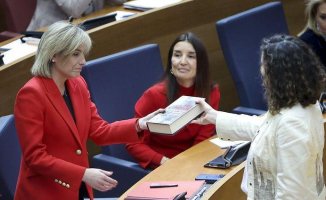I look. The most intimate arrival, which is being presented at the Fundació Joan Miró in Barcelona until September 26, is one of those infrequent exhibitions from which one can leave in a very good mood. For this to happen, certain conditions are required. The first is that the artist expresses a deep and positive connection with his life and with his art, which is fully fulfilled in this case. And the second is that the visitor also has a good harmony with the plastic work of the artist. And Joan Miró was a poetic and libertarian animal –in the best sense of these words–, a discreet, deep and wild creator, also in the good sense of this word.
It is, therefore, not only a matter of artistic excellence and visionary originality, but also of a vital, free and poetic attitude – that is, celebrating the best and criticizing the worst –, oriented towards a better deployment and development of the possibilities of the human experience. One can leave satisfied with a good exhibition of Picasso, Duchamp or Giacometti, but what a good exhibition of Miró –or also of Klee– can produce is, moreover, a desirable state of celebration, lucidity and freedom –at least internally. – which is typical of true poetry. And perhaps the best music too, even with greater emotional intensity, although the ethical commitment of music –if it lacks words– will always be less than that of the best literature.
The Fundació's exhibition focuses its attention on the paintings that Miró always wanted to keep in his family and that he gave to his wife, Pilar Juncosa, his daughter Dolors and his grandchildren. Without a doubt, these works were a reference for the artist himself and he was also right not to part with them for practical and patrimonial reasons. One of them is the first of the series of Constellations that he made as an affirmation of life and freedom in times of war and fascism: L' etoile matinale, 1940.
But there are many more, from all its eras. It is an exhibition that once again shows that intimate, poetic and lucid Miró that appeared in the first great biography of this artist: Joan Miró. The Boy Who Talked to the Trees, written by Josep Massot and published in 2018, until now only in Spanish and Catalan, although it is a world reference work that deserves to be translated into other languages. The independent and smart Miró that Massot portrays in a second book, Joan Miró sota el franquisme (2021), also appears.
Since the splendid exhibitions of his centenary in 1993, held in museums such as the MoMA in New York, the Fundació Joan Miró in Barcelona and the Reina Sofía in Madrid, Miró's work has been increasingly better understood and valued, even by a wide audience. In the period between the wars (1920s and 1930s) it was above all some poets – the best, precisely – who understood and praised Miró, and from the very beginning. On the other hand, in his own country, for more than half a century the author of the Constellations was an artist who was often undervalued or ignored. Those who also supported him were some gallery owners from Paris and New York. But still at the end of the 20th century, in many texts on art the 20th century was considered "The Century of Picasso". In art, however, the mythomaniac and monotheistic tendency is a mistake.
I remember that already in January 1988 I published a text in which I stated that the 20th century was also the century of Paul Klee, and in the following years – with all due respect for the work of the admired Picasso and the influential Duchamp – it became clear – at least for those who paid attention to his work – that the 20th century is also Miró's century. If Picasso's modernity brought the past up to date with new forms and Duchamp turned towards a cerebral and iconoclastic art, Miró's legacy goes beyond forms and aesthetics, but also iconoclastic and nihilistic gestures, and is oriented towards the future in a liberating, creative and vital sense.













